Colne 2-3 Workington- 2022/23 Matchday Blog #48
Joe Marshall- @AllSportJoe
In the shadow of Pendle Hill, one of Lancashire’s most iconic landmarks, is the quiet and unassuming market town of Colne. Located just a few miles from Burnley, the town naturally sits in an area steeped in footballing pedigree. The non-league scene in this particular region of Lancashire is thriving, in addition to Colne, the towns of Clitheroe, Padiham, Bacup, Nelson, Barnoldswick and Silsden all boast semi-professional sides, playing the beautiful game in the beautiful Pennine hills.
I made my first visit to Holt House, home of Colne FC, for their important Northern Premier League West fixture against promotion-chasing Workington on what was to be a wet Tuesday night under the lights.
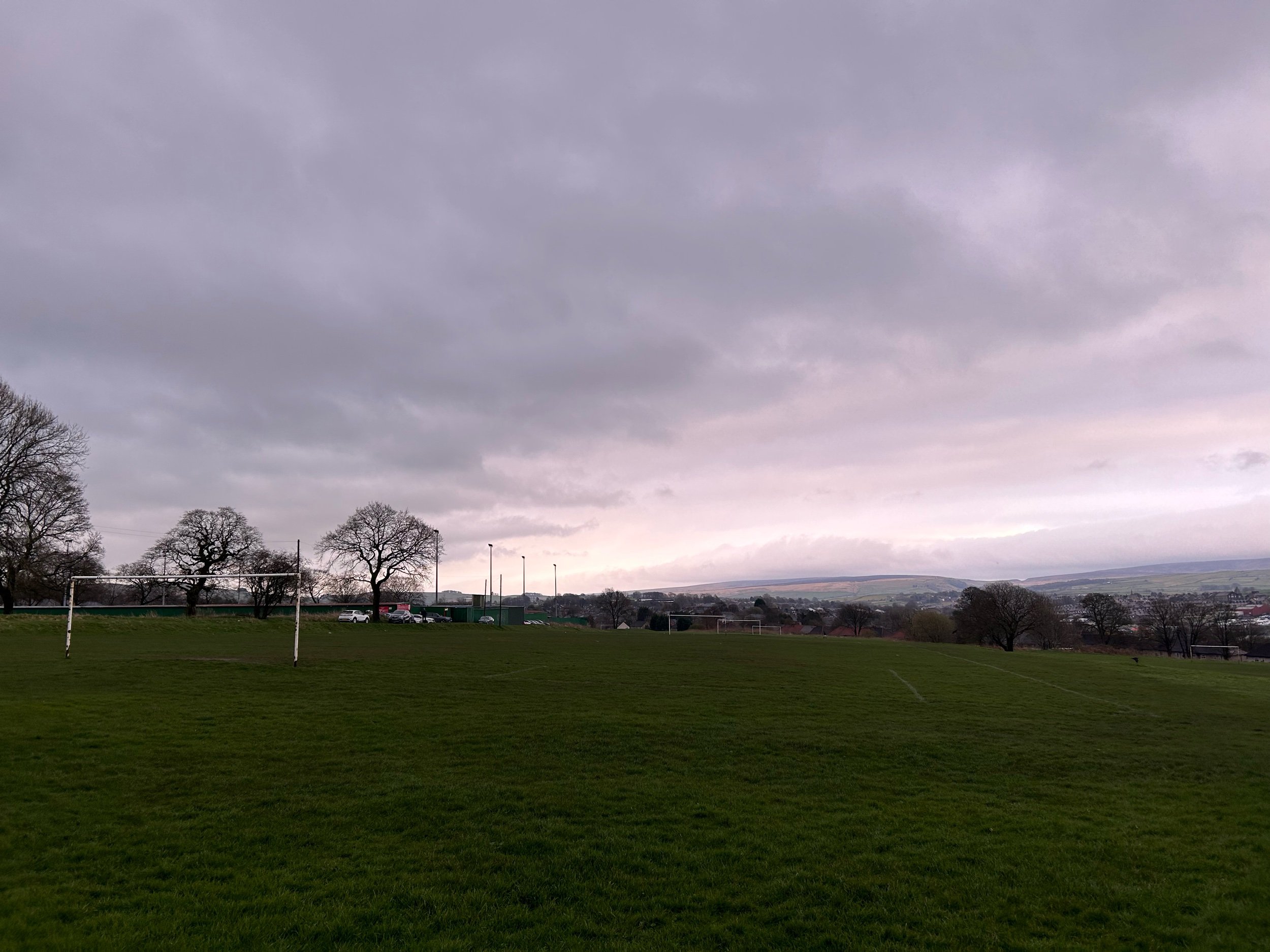
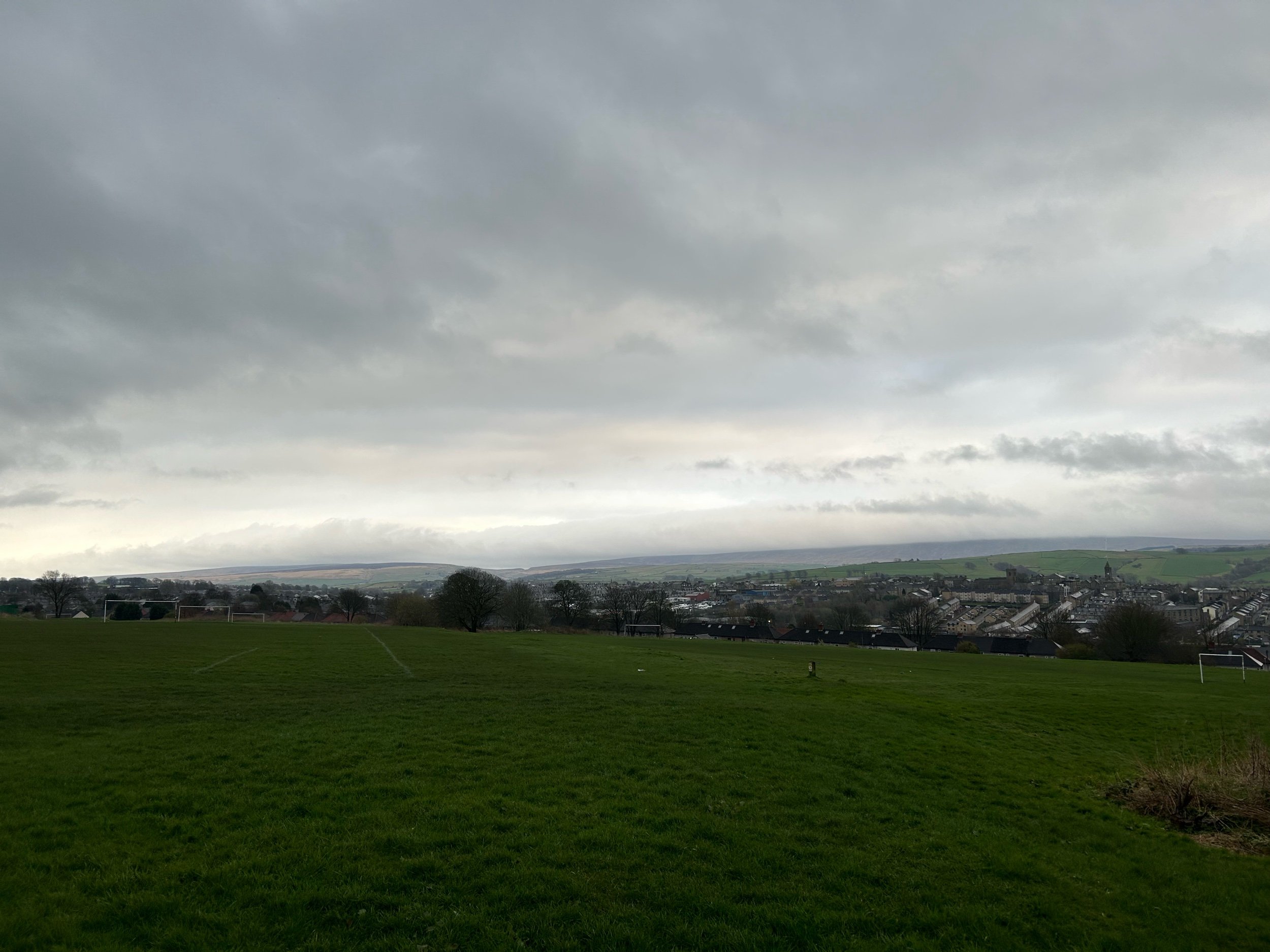
Holt House
Upon parking up a couple of hundred yards from the ground, I was immediately struck by the beauty of the surrounding area. When Burnley were in the Premier League, the town was often the butt of the Southern-based media’s jokes when needing to refer to an unfashionable place to visit. In the absence of Stoke, the Lancashire town became the target of ridicule thanks to its unglamourous location. Over the years, I felt myself falling into that trap, and unconsciously writing off this part of Lancashire as bleak and unworthy of appreciation. These prejudices were wiped away upon witnessing the sheer scale of the incredible surroundings. The astonishing views forced me to question everything that has ever been said about the region.
Holt House has been the home of the current incarnation of Colne’s football team since their inception in 1996. It was previously the home of Colne Dynamoes, the club that preceeded the current one. In 1975, the ground was enclosed as the Dynamoes moved into the Lancashire Combination League. In the style of a mini Hackney Marshes, the land on which Holt House sits still boasts several football pitches, which have also been part of the landscape since the Dynamoes days.
The ground sits on the top of the hill, next to a couple of the other pitches. The Holt House pitch is without doubt the most level playing surface of all the adjacent pitches, but this does not mean that it is flat. The charm of the ground comes with the way that the pitch slopes, the ground feeling truly at one with the undulating environment.
Once you enter through the turnstiles, directly ahead of you is a covered stand behind the goal. Its close proximity to the food outlet and the outside bar makes this stand the most popular spot for the home support, and its low roof provides good acoustics to enable the supporters to get behind their team. If you opt to turn right upon entry, you may find yourself in the clubhouse. It is small and cosy, and on a cold night like this, many fans definitely saw it as one of the better places to be. Continuing down the clubhouse side, there is a small stand that provides the ground’s only seated area. This stand sits centrally, with around 160 seats, with views partially obstructed by a number of supporting poles.
At the far end, opposite the covered stand behind one goal, is a rather empty space that sits at the bottom of the hill. The views at this end are limited, and only a handful of fans could be seen down there during any part of the game. Finally, spanning the length of the pitch opposite the clubhouse side is another fully standing area. Although it has no cover, it is a charming area kitted out with several picnic benches that would come in handy on a slightly warmer evening, and is home to some of the most characterful toilets I’ve ever used.
With a capacity of 1800, it isn’t the largest ground in the league by any stretch, nor is it one of the most luxurious. But this season has taken me to most of the grounds in the NPL West, and Holt House is certainly one of my favourites. It encapsulates everything that I love about non-league football. There is a simplicity to the place that allows you to fully immerse yourself in what you are witnessing. There are no frills, and no delusions of grandeur. What you see is what you get at Colne, and there is an honest beauty to that. The scenery is excellent, the sloped pitch is charming and the layout makes you feel like you’ve been to 10 grounds in one. It is a stunner.
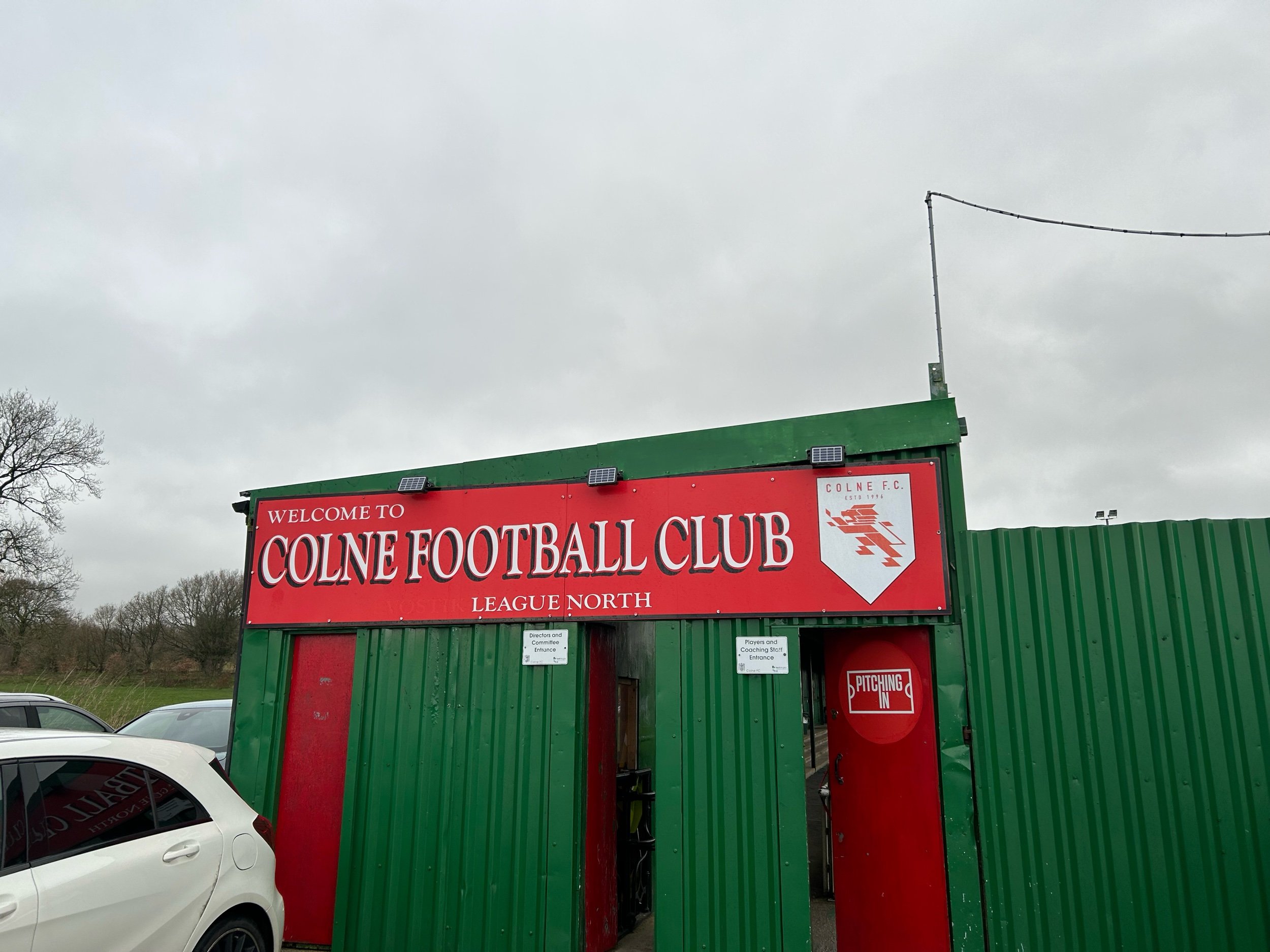

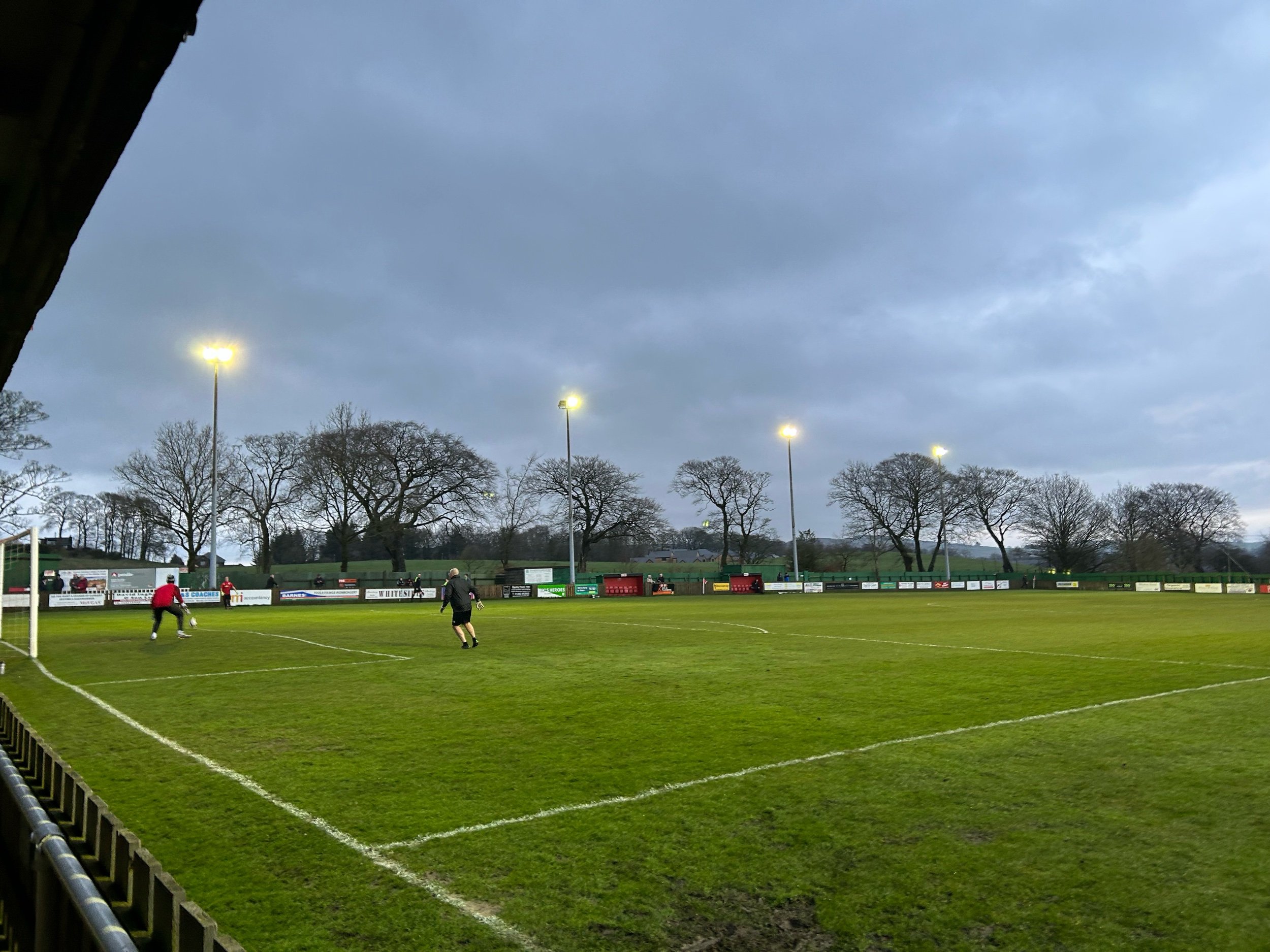
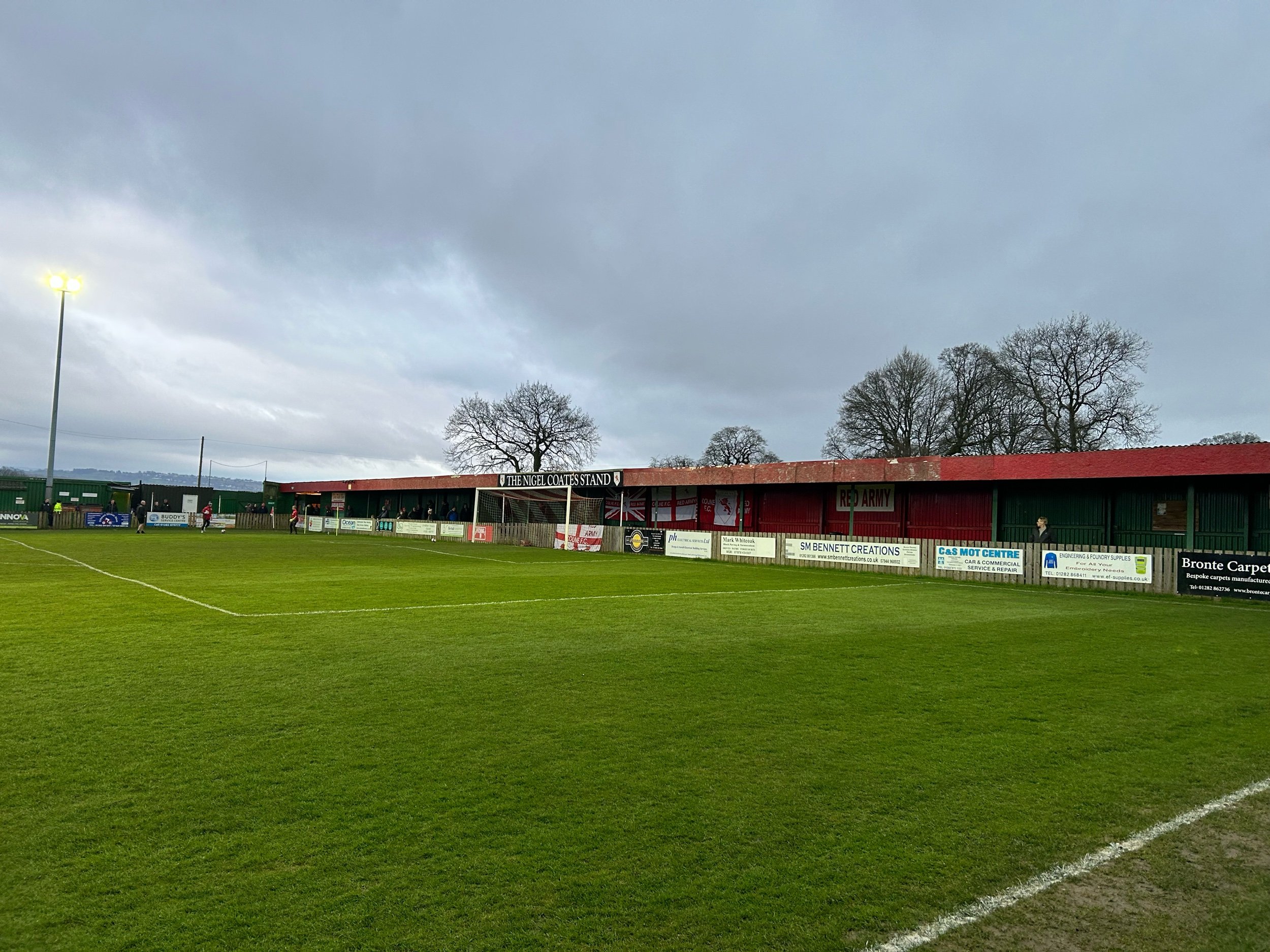

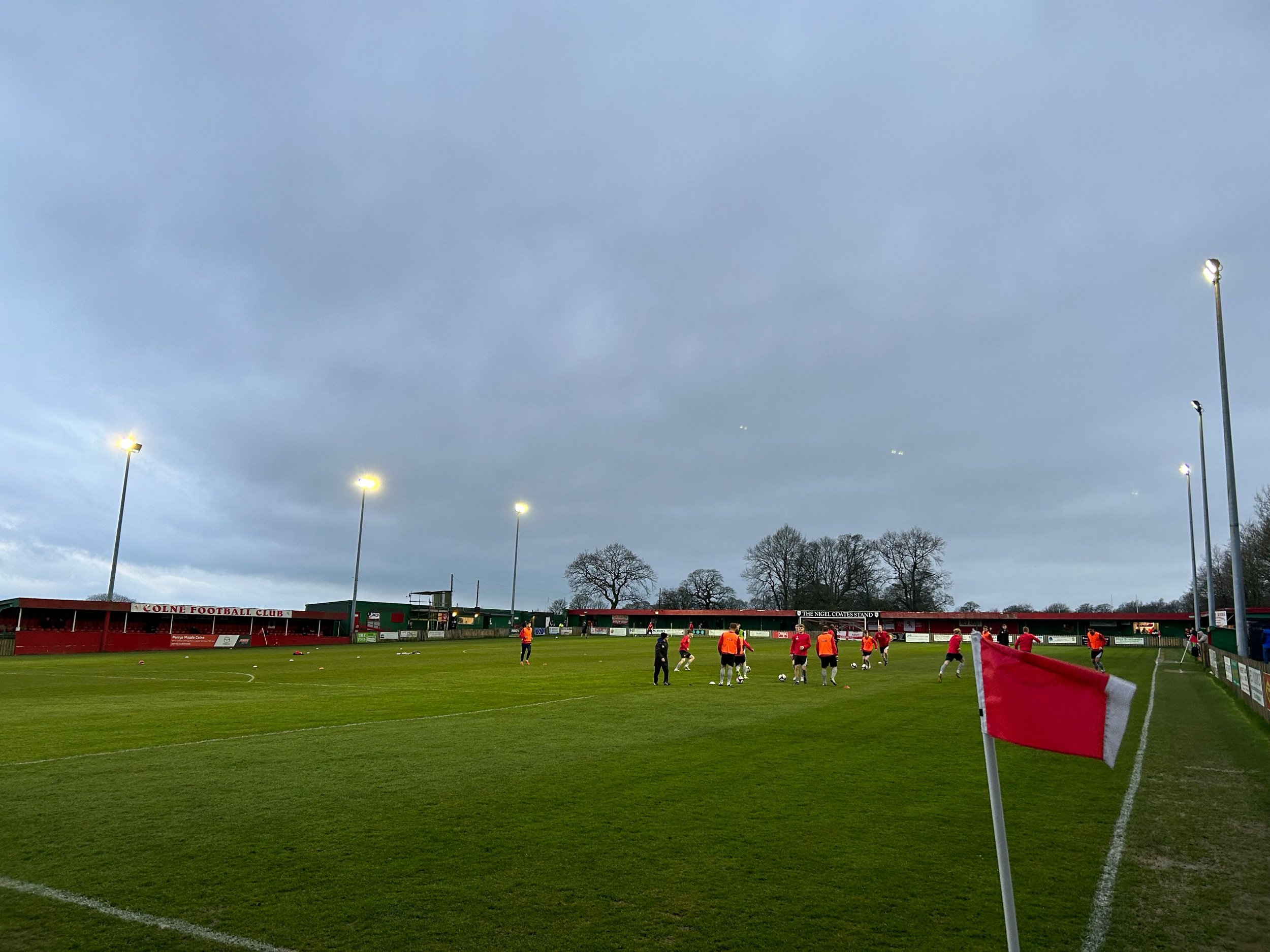
Holt House Experience
Admission was £9, one of the cheaper entrance fees in the league, but sadly there was no programme for me to read prior to the game. There was a QR code in the covered stand behind the goal telling me to scan for the online edition, but unless the programme is named ‘Error 404’, it remained elusive.
The food and drink options were excellent, my burger and chips were the perfect way to fill the hole that I always deliberately leave when going to a game, and the branded cup idea was fantastic, something that every club should be doing. For £4, I received a pint of Madri, but for an extra £2, I put my deposit down for my red Colne branded cup. Needless to say, that cup now lives in my cupboard, and every time I pour myself a glass of water, I am reminded of this excellent little ground in Lancashire!

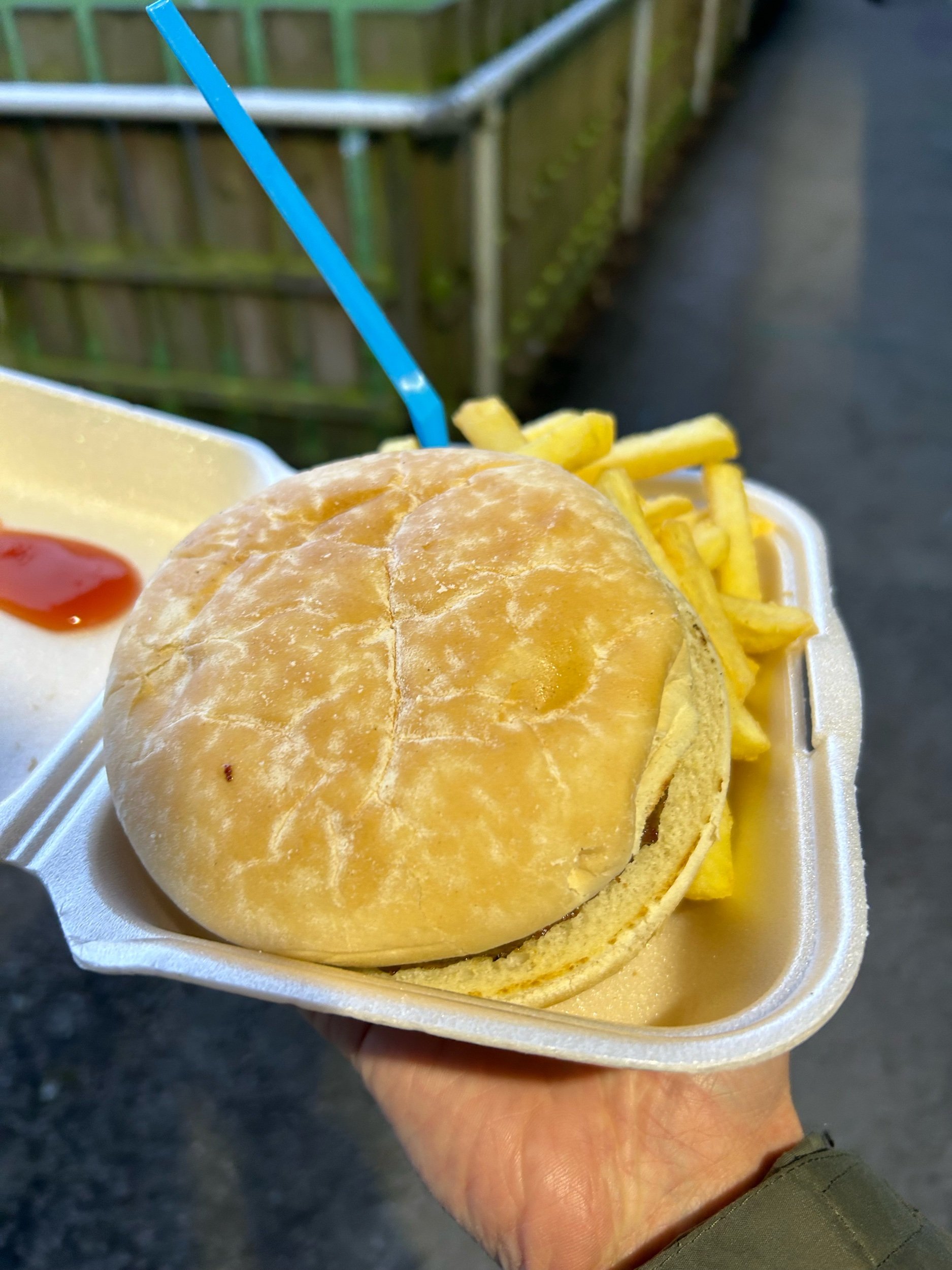
Colne FC
When Colne Dynamoes disbanded in 1990, there was a football club shaped gap in Colne, and particularly at Holt House. Although the Colne Royal British Legion Football Club briefly moved in, there was still a club missing from the town, particularly as they ceased to exist suddenly after the most successful spell in their history.
Dynamoes were once a force in Northern non-league football. They won the FA Vase in 1988 as well as a number of league titles across the North West Counties Football League and Northern Premier League. As Northern Premier League champions in 1989-90, they were only a ground grading ruling away from participating in the Conference. Despite winning the league, promotion was to be denied on the basis of Holt House failing to meet the requirements. A groundshare agreement was sought, but could not be found, therefore owner Graham White, the man who had been at the club since their formation in 1963, pulled the plug and the Dynamoes disbanded that very summer. It wasn’t until six years later, that the current Colne Football Club was formed, starting life in the NWCFL.
The Vase-winning Dynamoes side of 1988. The club would fold two years later. Credit: The Non-League Paper
In Colne FC’s first season, 1996-97, they participated in the NWCFL Division Two, and it wasn’t the start that new committee, including Dave Blacklock would have hoped for. They finished bottom of the league with 23 points, but football was back in Colne, and back at Holt House, so there were still some positives to be taken. None more so than the performance of the reserves side, who won the BEP Cup.
For the side nicknamed ‘The Reds’, things began to improve, and their final league positions started to slowly rise. With the exception of a minor blip in 2001, when Colne finished 19th, they rose steadily up the Division Two table, culminating in an excellent season in 2003/04, in which they were crowned champions and earned promotion to the First Division.
This season also saw Colne record their best ever result in the FA Vase. The club formed in the ashes of the 1988 winners reached the semi-final stage, defeating AFC Wimbledon along the way. They were eventually eliminated in the two-legged semi-final by AFC Sudbury, with the Holt House leg attracting a record crowd of 1,742.
In their first season in the First Division, (later named the Premier Division) they consolidated with a solid 10th place finish. They remained mainstays of mid-table between 2004 and 2015, without really threatening the promotion picture, or ever looking too closely over their shoulders towards relegation.
Their period of status quo changed though in 2015/16, when Colne won promotion into the Northern Premier League Division One North, thanks to a fantastic 100 point, 105 goal season. This meant that they would now be playing step 4 football for the first time in their history.
Colne celebrate lifting the NWCFL Premier Division trophy. Credit: NWCFL
The Reds finished a very creditable 5th in their first season in their new league, and followed that up with two more top half finishes, including a playoff semi final defeat to Leek Town. The Covid-19 pandemic saw disruption to non-league football in 2019/20 and 2020/21, and Colne have justiification to feel more hard done by than most. When the 2020/21 season was scrapped after just a handful of games, The Reds found themselves top of the NPL West, but have struggled to regain that kind of form since. Ahead of the game against Workington, Colne find themselves embroiled deep in a relegation battle, looking to avoid a return to the NWCFL.
Workington AFC
Workington are the most northern team in this season’s NPL West division. The Cumbira based side made the trip of approximately 130 miles for this Tuesday evening kick off.
They are also one of the oldest and most storied teams in the division, with a history dating back to 1888. They began life participating in the Cumberland Association League, before hopping around into the Cumberland Senior League, then the Lancashire League before returning to the Cumberland Senior League. Workington folded shortly after, but reformed again as the club we know now in 1921.
Workington’s history features some of the great names of English football. During their Football League spell, they were managed by Bill Shankly. The man who would go on to become a legend at Liverpool cut his managerial teeth with Workington for almost two years in the mid-1950s. Another legendary manager, Matt Busby, took his Manchester United side to Workington’s Borough Park in January 1958 for an FA Cup Third Round tie. The game drew a record crowd of over 21,000. Although historic, the tie is tinged with an air of sadness, as little over a month later, eight United players would perish in the Munich disaster. The links to Manchester United legends don’t end there though, as the iconic George Best once turned out for Workington in a charity match as the the club desperately sought funds. A slightly lesser known name, goalkeeper John Burridge, made his name at Workington, and went on to become one of football’s greatest journeymen, racking up nearly 800 games for 31 clubs in a 28 year career.
Bill Shankly during his time at Borough Park
Ironically, Workington also go by the nickname of ‘The Reds’, making this blog a nightmare for second mentions! The Cumbrians spent nearly three decades as a Football League side, between 1951 and 1977. During this spell, they were mainstays in the Third and Fourth Divisions, with a high of fifth place in the third tier in the 1966 season. Their Football League experience featured two trips to the quarter final stage of the League Cup, in 1964 and 1965. However, this purple patch in the mid-1960s was the club’s Football Leauge pinnacle, as they were shunted back down to the Fourth Division in 1967. Their Football Leauge era came to an end in 1977, when they were voted out of the league, being replaced by Wimbledon. Following this, the Reds began a slide into the depths of non-league.
They eventually found themselves in the North West Counties Football League, but were crowned champions of the First Division at the first time of asking in 1999. Promotion to the NPL Premier Division was secured in 2004 via a 7th placed finish, as this position was enough to see them placed in the NPL’s top tier when the league was restructured that summer. The following season, they climbed into the Conference North, thanks to a playoff final victory against Farsley on penalties. This, incidentally, was the first time the playoffs had been used at this level.
Once in the Conference North, they managed to make the playoffs on two separate occasions, in 2008 and 2010. Unfortunately for the Reds, they were defeated by Hinckley United and Alfreton Town respectively. Their time at step 2 came to and end in 2014, when they finished bottom of the Conference North. They tried and failed repeatedly to reclaim their place at the highest level of regionalised football, with playoff defeats in three successive seasons. These near misses came back to bite Workington in 2019, as they suffered relegation back to step 3, falling into the NPL West. Like Colne in those embryonic weeks 2020/21, Workington will no doubt rue the impact that the pandemic had on football, as they sat at the top of the league when football stopped in March 2020, and the null and voided season meant that they could not see out their promotion.
Fast forward to the present day, and Workington are chasing a spot in the playoffs. They will see an away trip to a struggling Colne side as a perfect opportunity to pick up three more points.
The Match
The first half began with the visitors attacking downhill, towards a pocket of die hard supporters who had made the trip from Cumbria. In the early exchanges, Colne more than held their own, seemingly not afraid to take the game to Workington, despite a poor record of results against the Cumbrian Reds.
Midway through the first half, the weather conditions began to deteriorate, and the wind and rain brought the game’s opening goal, and it was a well taken, composed finish by Workington’s Scott Allison, who lifted the ball over the sprawling Hakan Burton in the Colne net.
This goal allowed the away team to assert themselves more on a game that was arguably 50/50 up until that point. Burton had to be at his best on a couple of occasions as the half progressed, denying Workington with a smart save with his feet from a snap-shot, and by getting down low to push away a long range effort.
Despite being 1-0 down as the break approached, Colne didn’t look like a defeated side. They were certainly up for a battle. The game took on a fiesty nature that looked very close to boiling over, with the rain creating a heavy pitch that meant every challenge felt just that little bit tastier.


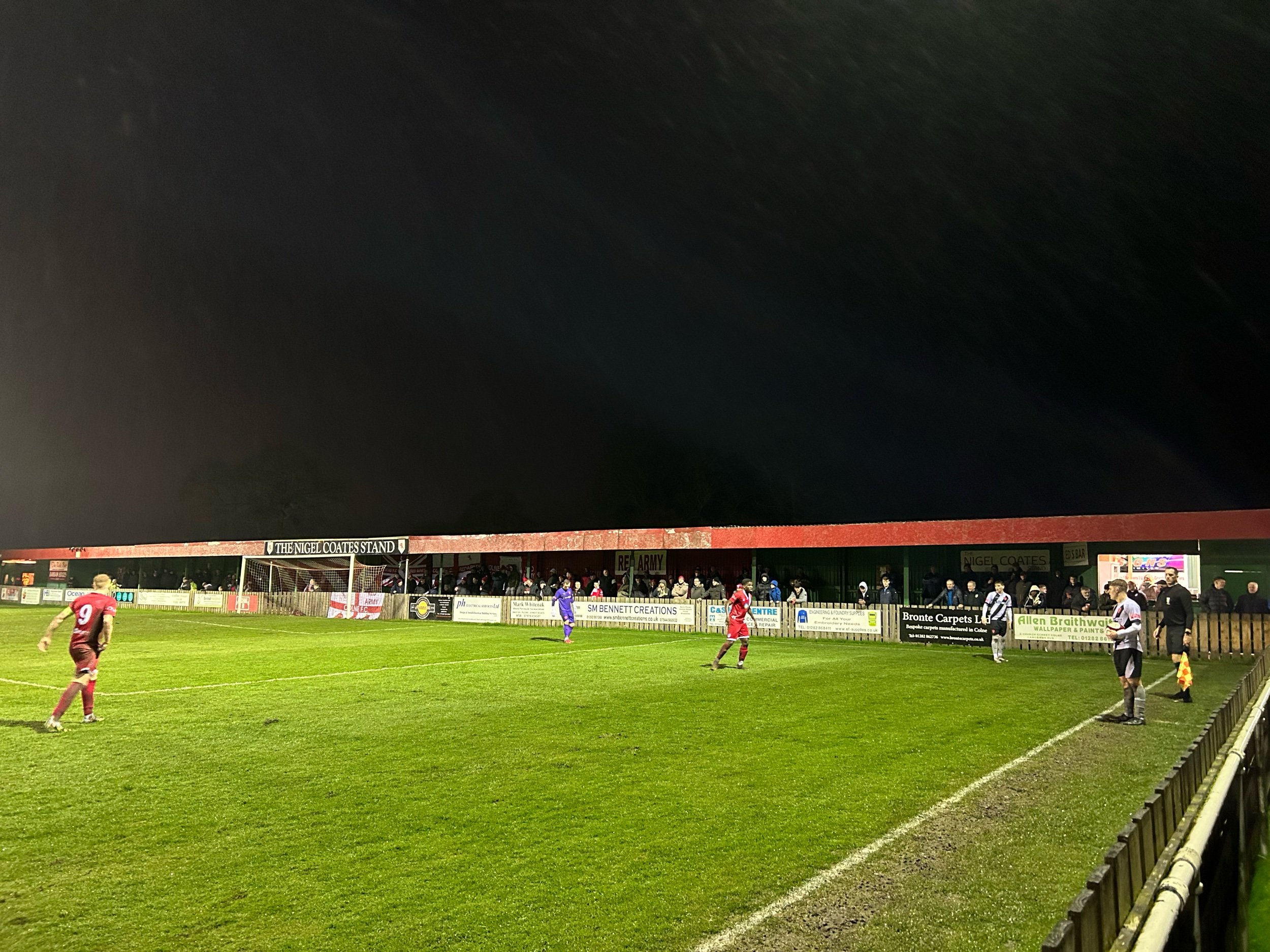
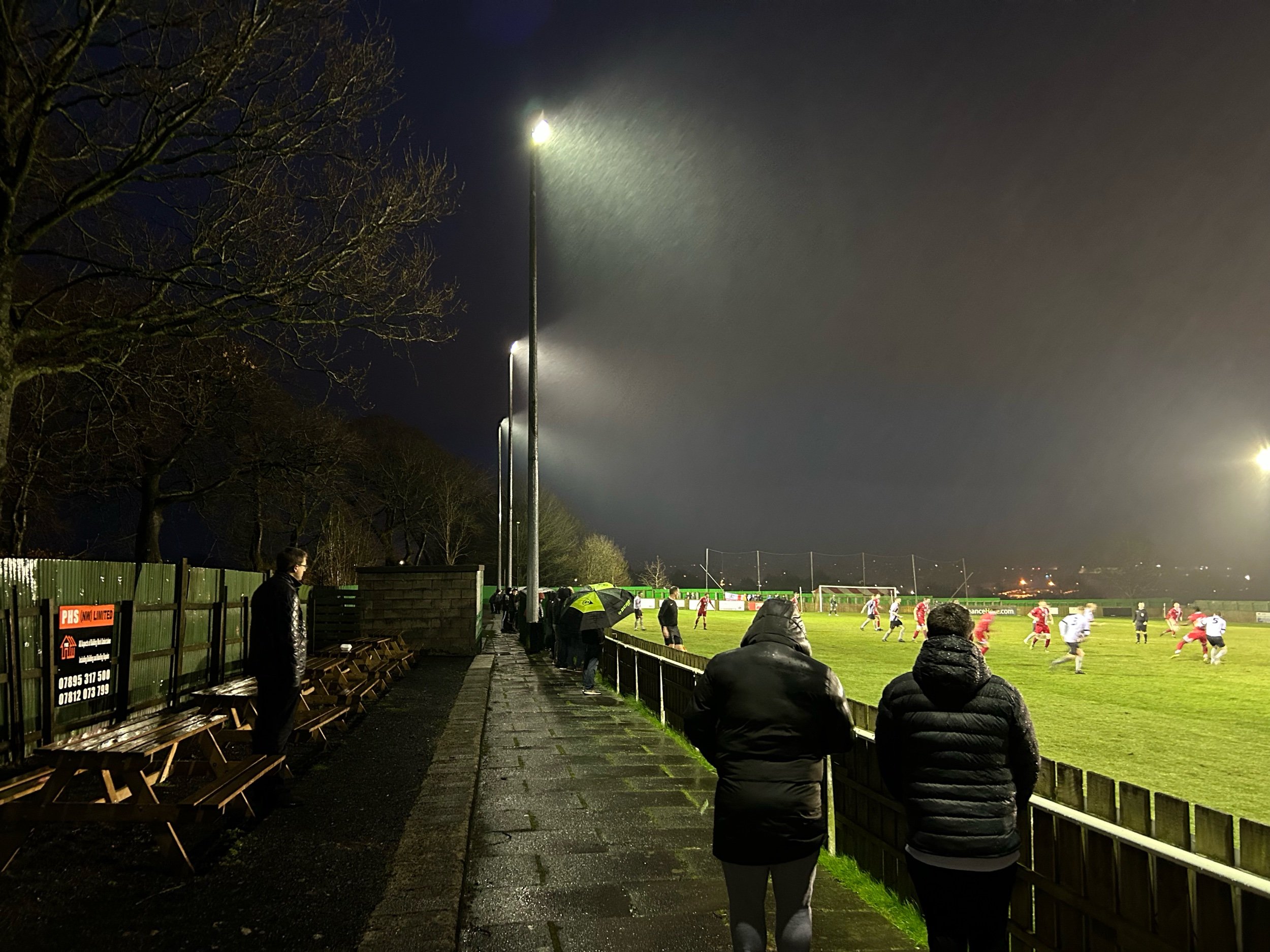
Just before the break, the intense nature of the rain gave the referee a decision to make regarding the viability of the game continuing. As he called the managers over to have a brief discussion about the playing conditions, it wouldn’t have surprised me if he also had a word with them about getting the players to rein in some of their tackles, as if the game was to finish, it looked unlikely to finish with 22 players on the pitch.
The first half drew to a conclusion with Workington leading by a goal to nil. Colne were to have their work cut out to salvage anything, but they could take comfort in the fact that they would now have the benefit of kicking downhill.
As the second half started, it was obvious that Workington were fired up to add to their lead. Although they eventually managed it, it took them until the 70th minute to find that elusive second goal, in a second half that until that point was lacking in any clear cut opportunities.
Ruben Jerome was the benefactor of a fairly fortunate ricochet in the box, and when the ball fell kindly at his feet, he buried a shot past Burton at the near post. Workington added a third shortly after from the penalty spot. A tired, clumsy Colne challenge gave the referee no choice, and it handed Connor Tinnion the opportunity to seal the victory, which he did confidently, sending the goalkeeper the wrong way.
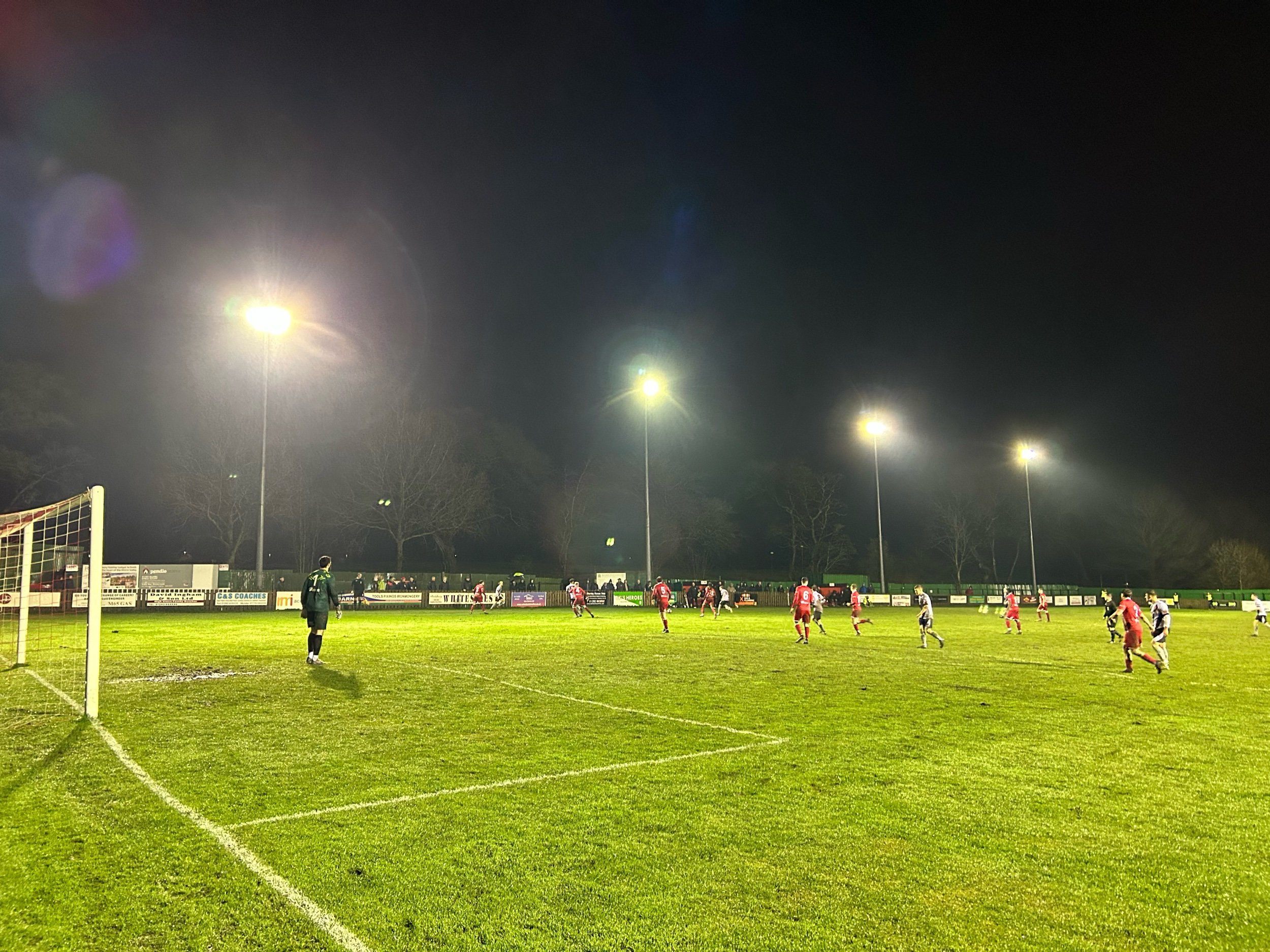
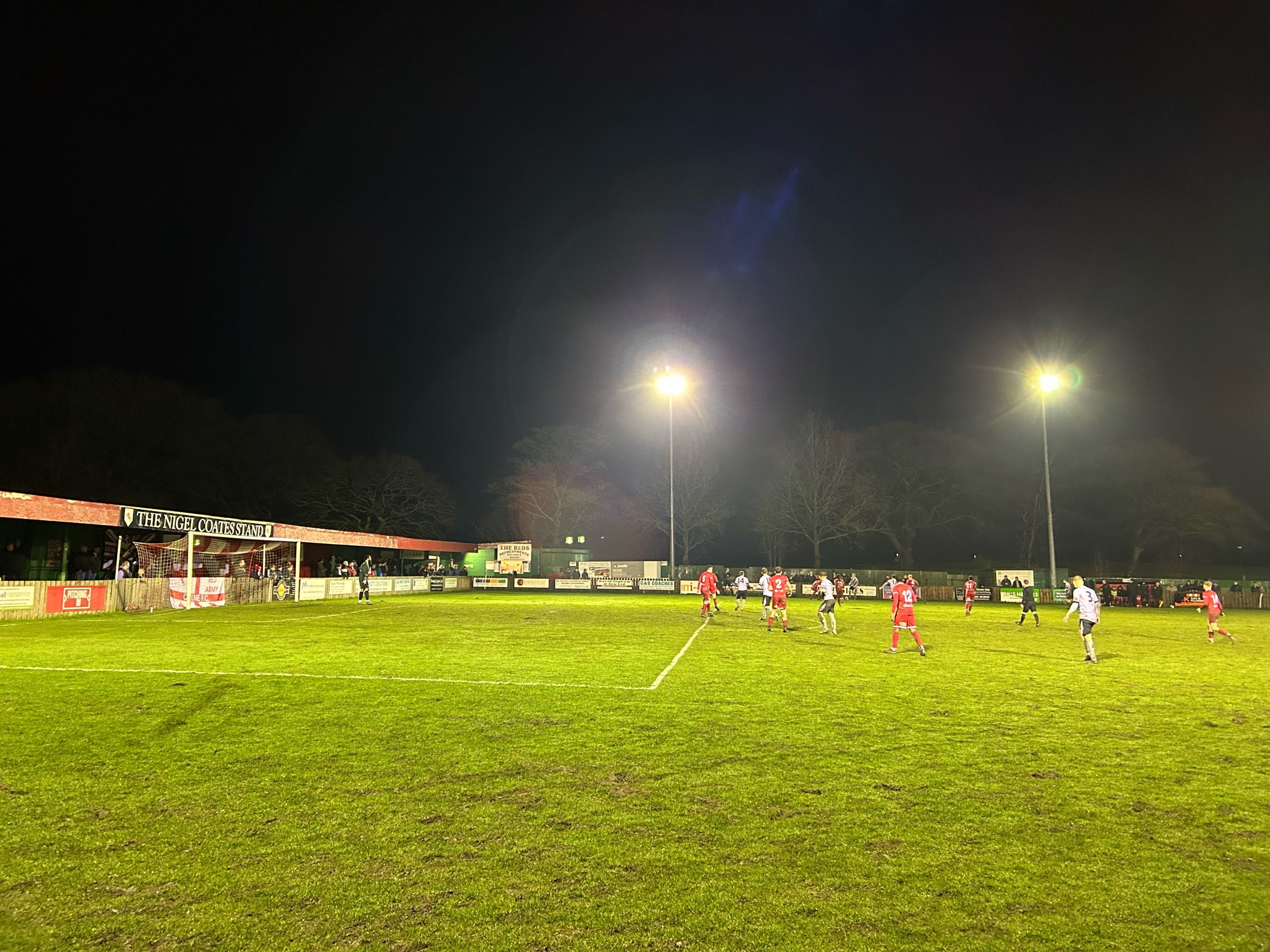
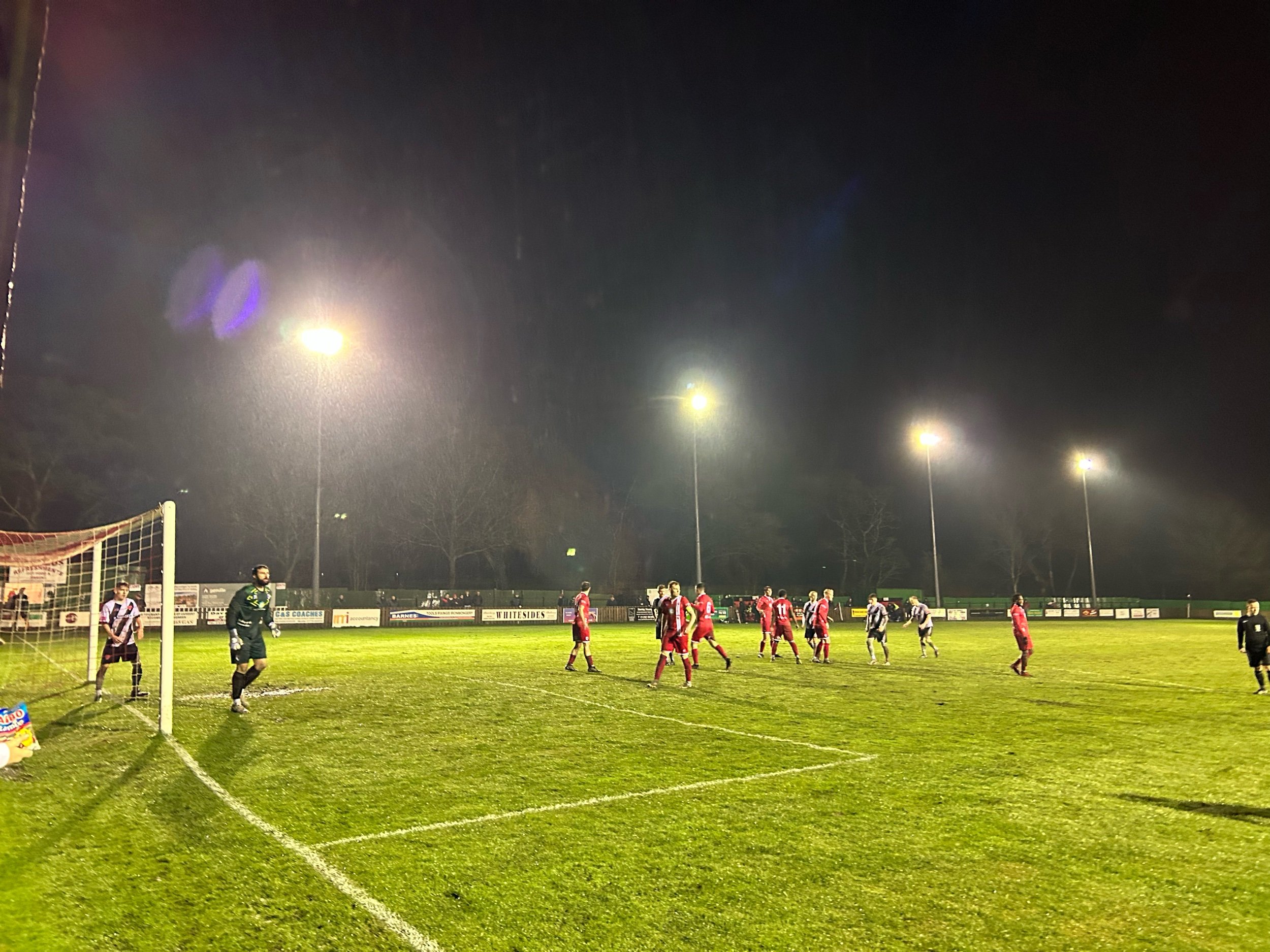
At 0-3, it looked as though the game was over as a contest, but Colne came back into the game to set up a grandstand finish. Colne’s first came in the 89th minute, and it was an excellently taken strike by Malik Diakite, who leathered his shot into the corner from the edge of the box.
This gave Colne hope as well as momentum, and they won another corner a couple of minutes later. A well worked routine saw a low ball fizzed across the 18 yard box to the unmarked Mateusz Kardacz who produced a deft finish to make it 2-3. This ending set the pulses racing inside Holt House, and the climax got even more dramatic when the referee found a little more stoppage time to allow Colne one more opportunity, again from a corner. The home side tried another clever routine, but this time to no avail, meaning that Workington could survive the scare and hold on for the three points.
A game that could have quite easily been abandoned in the first half, turned out to be one of the most entertaining that I’ve seen this season. Colne gave a very good account of themselves, but ultimately gave themselves too much to do, with too little time to do so. Workington looked composed and clinical in attack, but would perhaps be slightly concerned with how hard they made it for themselves by full time.
Despite the heart-stopping finale, my biggest take-away from the evening was my newly-found fascination with Holt House, a tremendous football ground, set in a idyllic location. Relegation looms large over the Lancastrians, but whatever league Colne find themselves in next season, as long as they’re still at Holt House, they’ll be just fine.
Final Score: Colne 2-3 Workington
Attendance: 271
Admission: £9
Programme: N/A







